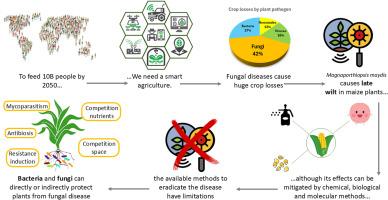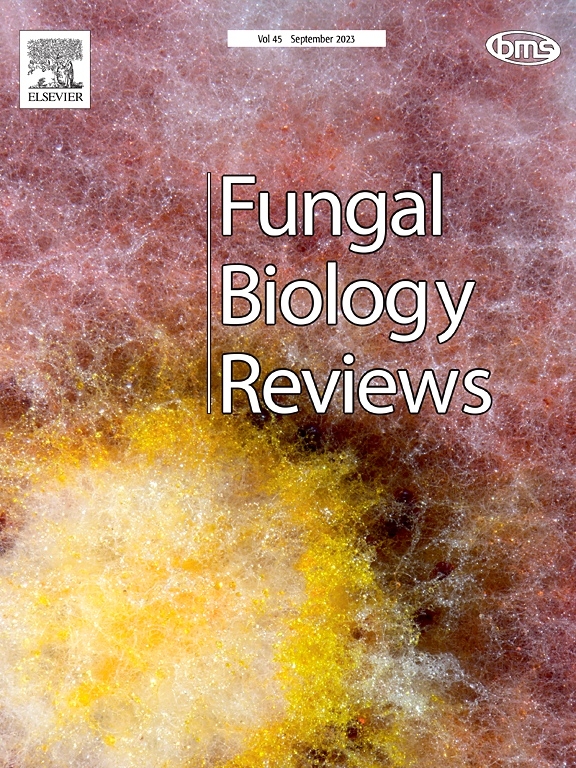Challenges in maize production: A review on late wilt disease control strategies
IF 4.6
2区 生物学
Q1 MYCOLOGY
引用次数: 0
Abstract
Maize production faces many challenges such as fungal infections causing substantial crop losses, with 10–23% annual losses, despite fungicides use. Late wilt disease (LWD), caused by Magnaporthiopsis maydis, is one of these infections. This review shows that although extensive research has been done on identification and detection of pathogen and control methods to mitigate disease impacts, there are still some key factors poorly known, such as interaction with other pathogens and with secondary hosts, mechanisms triggering infection and influence of climate change on disease spread and severity. The method widely used to control this disease is the use of resistant varieties, which are threatened by the development of virulent fungal strains. Despite the availability of agrochemicals on the market such as azoxystrobin, their application can be expensive and increase fungicide resistance may impair their efficiency. Currently, phytopathologists are working to identify new biocontrol agents in plants and soil, however the use of these agents may not be sufficient, and their application can be challenging. The limited information on the biochemical and physiological mechanisms of infection and on plant biochemical, physiological and nutritional status during and after disease and their sensitive to environmental conditions may contribute to the lack of more effective methodologies of disease control. The application of biocontrol agents alone or in combination with conventional strategies emerges as a sustainable alternative that can efficiently control the disease.

玉米生产面临的挑战:晚疫病控制策略综述
玉米生产面临着许多挑战,例如,尽管使用了杀真菌剂,但真菌感染仍会造成每年 10-23% 的重大作物损失。由 Magnaporthiopsis maydis 引起的晚疫病(LWD)就是其中之一。本综述表明,尽管在病原体的识别和检测以及减轻病害影响的控制方法方面已经开展了大量研究,但仍有一些关键因素鲜为人知,例如与其他病原体和次要寄主的相互作用、引发感染的机制以及气候变化对病害传播和严重程度的影响。广泛用于控制这种病害的方法是使用抗病品种,而这些品种正受到毒力真菌菌株发展的威胁。尽管市场上有唑啉草酯等农用化学品,但其应用成本高昂,而且杀菌剂抗药性的增加可能会影响其效率。目前,植物病理学家正在努力寻找植物和土壤中新的生物控制剂,但这些控制剂的使用可能并不充分,其应用也具有挑战性。关于感染的生化和生理机制以及植物在发病期间和发病后的生化、生理和营养状况及其对环境条件的敏感性的信息有限,这可能是缺乏更有效的病害控制方法的原因之一。生物防治剂的单独应用或与传统策略的结合应用成为一种可持续的替代方法,可有效控制病害。
本文章由计算机程序翻译,如有差异,请以英文原文为准。
求助全文
约1分钟内获得全文
求助全文
来源期刊

Fungal Biology Reviews
MYCOLOGY-
CiteScore
10.60
自引率
0.00%
发文量
36
期刊介绍:
Fungal Biology Reviews is an international reviews journal, owned by the British Mycological Society. Its objective is to provide a forum for high quality review articles within fungal biology. It covers all fields of fungal biology, whether fundamental or applied, including fungal diversity, ecology, evolution, physiology and ecophysiology, biochemistry, genetics and molecular biology, cell biology, interactions (symbiosis, pathogenesis etc), environmental aspects, biotechnology and taxonomy. It considers aspects of all organisms historically or recently recognized as fungi, including lichen-fungi, microsporidia, oomycetes, slime moulds, stramenopiles, and yeasts.
 求助内容:
求助内容: 应助结果提醒方式:
应助结果提醒方式:


